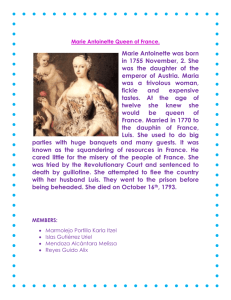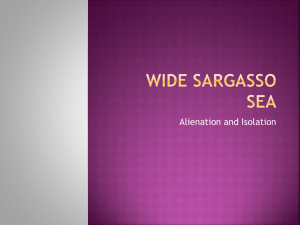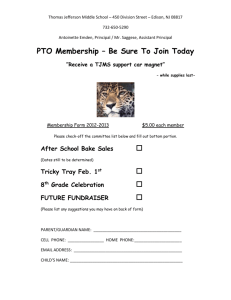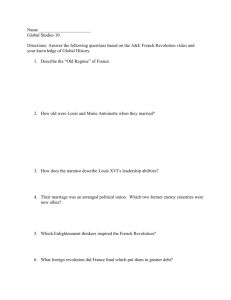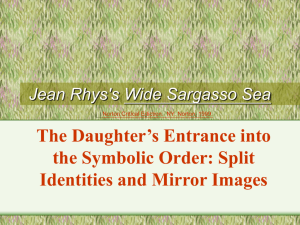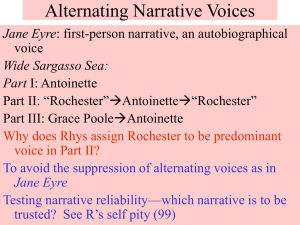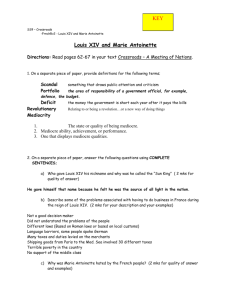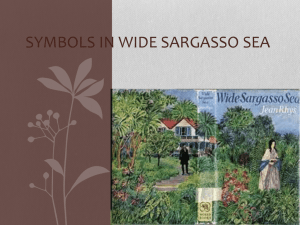Creole Identities and Racial Relations in Jean Rhys's Wide
advertisement
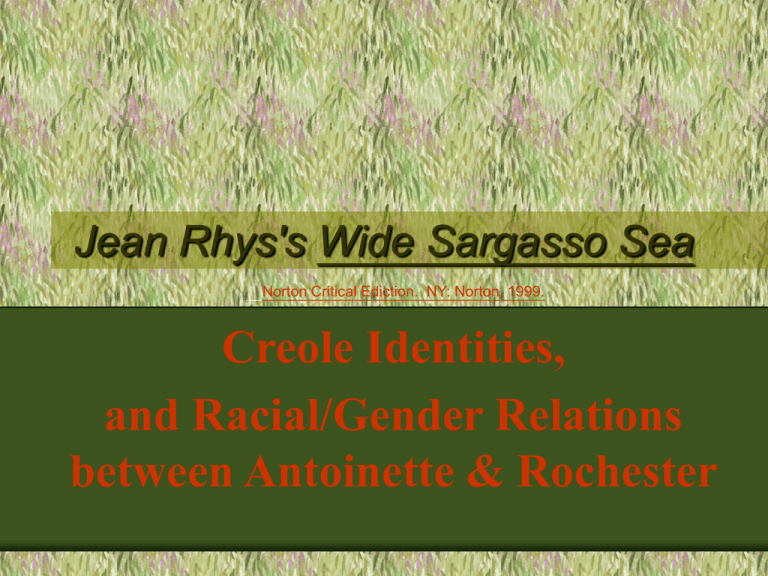
Jean Rhys's Wide Sargasso Sea Norton Critical Ediction. NY: Norton, 1999. Creole Identities, and Racial/Gender Relations between Antoinette & Rochester Outline 1. Antoinette’s personality and the causes for it 1) Antoinette’s personality 2) Annette: a) The Creole Identities of Annette; b) Annette as a Woman; c) madness Gender+Race 3) Antoinette: a) loss of mother; b) as a creole; 3) convent 2. The problems in Rochester and Antoinette’s marriage 1) Race & Gender & marriage 2) Good moments; 3) Causes: a) cultural difference; 2) R’s racial prejudice; 3) R’s self-centeredness; 4) the letter; 5) A’s sense of doom; 6) C’s role WSS: Settings • Part I: (Martinique), Jamaica: Coulibri estate, near Spanish Town Part II: Granbois, Dominica, Part III: “Great House” England Rhys on Jane Eyre • "The creole in Charlotte Bronte's novel is a lay figure -- repulsive which does not matter, and not once alive which does. . . . For me . . . she must be right on stage. She must be at least plausible with a past, the reason why Mr. Rochester treats her so abominably and feels justified, and the reason why he thinks she is mad and why of course she goes mad, even the reason why she tries to set everything on fire, and eventually succeeds. . . " (Gregg 82; emphases added) Central Questions • How does Rhys characterize Antoinette? What are the causes for her personalities? – Mother-daughter relationship; – Her identity as a Creole and her childhood experience; – Convent education • How does she explain the problems between Antoinette and Rochester? – their socio-historical context—19th Century Victorian/Colonial world? Race + Gender – Anything we can related to? Background: Before and after the Emancipation Backgrounds on Race: I. white masters, New & Old: • Old Masters: death of Mr. Lutrell and Mr. Cosway • New masters after the Emancipation of slaves p. 15 • [Mr. Mason – 19, 21] Background (2): Before and after the Emancipation Post-Emancipation Problems: 1. Recompensation, 2. Importation of contract laborers 3. Annette’s distrust of Christophine, Godfry, and Sass’ leaving p. 12 4. Riot: The presentation of the black mob p. 23, 25 Antoinette’s personality: 5 examples • • • • Childhood: e.g. the horse p. 10; garden 13; 16 recurrent dreams pp. 15, 27, 36 Attempt to turn down the marriage p. 46; the two rats & the moon p. 49 – death impulse p. 54 Insecure; in lack of a firm sense of identity; (lack of love, fear of others’ and society’s criticism, feeling excluded.) Fatalistic (fear of “madness” as a hereditary trait) childhood as a creole woman Creole Women’s Positions: Annette Annette: 1) multiple alienations of the creole —from the white people in the Spanish town (9; 17)—because she is Creole, from Martinique and poor; -- from the blacks (“they”) because she is former slave-owner and poor: pp. 10, 11 -- both Annette and Antoinette—seen as “white cockroaches” (13)/”white nigger” (14) Creole Women’s Positions: Annette Annette: -- 2) As a woman – a. Cosway: a womanizer; calls Daniel’s mother “sly boots” p. 74; halfway house p.57 b. widowed Antoinette (solitary life) Antoinette (planned and hoped) p. 10 -- marooned & her son 11 -- borrow a horse from the new Lutrelles gay and a good dancer c. Mason does not understand the racial relationship (19, 21) Creole Women’s Positions: Annette Annette: -- 3) as a creole woman a. Why does she care so much about the parorot CoCo? 25 b. The climax in Part I: are the black people just a violent and insensible mob? (p. 26) c. Antoinette’s account of what happened to Annette: 78; 80-81 Creole Women’s Positions: Antoinette Antoinette: (1) loss of motherly love • Her love rejected by Annette p. 11; 13, • The mother cares more about Pierre 16; • Annette ashamed of her 15; • Being pushed away after her madness pp. 2829 • missing her mother in the convent 34; • The mother’s death 36 Creole Women’s Positions: Antoinette Antoinette: (2) Race Relations – a. Christophine: helpful but fearful – – like a substitute mother; feared by Antoinette 18 -- Combination of Catholicism and voodoo (1. Antoinette’s seeking for help: p. 67, 68, 70 2. Put in jail once and may still be. P. 86) Creole Women’s Positions: Antoinette a. Antoinette and Tia – • friendship (13-14), • divided by racial differences (27) b. The boy and the girl 29-30 Creole Women’s Positions: Antoinette Antoinette (3): Gender and the Convent • the second refuge in the convent p. 32; 33; 34 Creole Women’s Positions: Antoinette (& Annette) a. • • b. • Imagery: Garden the biblical myth of the garden--(11) associated with snake and forest Imagery: Mirror Annette 10; p. Antoinette & Tia; the convent Part II: What causes the problems between Antoinette & Rochester? Is Rochester completely to blame? Sargasso Sea: Race and Gender • Why is the marriage between Rochester and Bertha unhappy? • Why is Bertha mad? Beast, madness in the family, driven mad, or not really mad? Gender – Marriage & Inheritance system Race White – Creole --Black Man Women Man Women Obeah woman Gender/Race Relationships among the Character Mr. Cosway, Pierre Daniel Godfry Sass Myra Spanish Town Whites p. 17 Father The Masons E. Rochester Richard Aunt Cora p. 18, 68-69 •Antoinette Annette Christophine Amelia Good Moments in their relationship • Rochester’s sense of peace in nature P. 41 • Arrival at Granbois p. 42; • The first night 49-50 Gender/Race Relations Women Unequal Relationships in Marriage • (about Mason’s marriage: p. 17) • Gender: Rochester’s Marriage and Inheritance: p. 41; 69 • “Dear Father” letters p. 39; But there are other factors . . . What causes the problems between Antoinette & Rochester • 1. (Race) Cultural differences A. her limited understanding of the world --- p. 42 “Oh England, England,” 66-67 -- p. 47 her “Paris”; ”Is it true,' she said, `that England is like a dream?” B. his illness and discomfort: p. 40, 41, blanks in his mind 45; p. 55 insecure Part II: Causes for the conflicts between Rochester and Antoinette: 2. (Race) Rochester’s prejudice and racial superiority p. 39; p. 43 Rochester’s connection with the priest • the priest's ruined house--Pere Lilievre--Pere Labat pp. 62-63; 83 3. Gender: Rochester's self-centeredness, possessiveness and pretentiousness • Agreed to everything 39; “not yet”; • not love her; perform and hide things p. 45, 61 • P. 55 watch her die many times • Turning Antoinette into Bertha pp. 68, 81 Part II: Causes for the conflicts between Rochester and Antoinette (2) 4. Race+ Gender: the letter from Daniel Rochester's suspicion of Antoinette’s madness (pp. 56 - ) • 5. Race+ Gender: Antoinette's temperament--sense of doom and insecurity • (6. Race+ Gender: 7. Antoinette’s seeking for help from Christophine) For next time: The Turning Point • Are Christophine’s suggestions practical? pp. 65 -; What stops her from being helpful? • Would their marriage have been saved without the voodoo?
